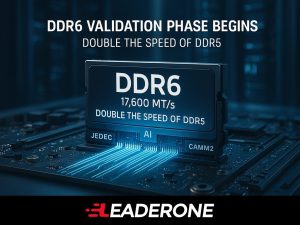
DDR6 memory module undergoing validation, labeled 17,600 MT/s, mounted on CAMM2 server board with AI data center in background
The next major leap in computing is on the horizon. DDR6 memory has now entered the critical phase of platform validation. This new standard, set to be finalized by JEDEC, promises to double the performance of its predecessor. With initial specifications starting at a blistering 8,800 MT/s and a top-end speed of 17,600 MT/s, DDR6 will redefine memory performance. This dramatic increase in speed is crucial for the future of AI, data centers, and high-performance computing.
The DDR6 Advantage: Beyond Just Speed
While DDR6’s speed increase is its most talked-about feature, it’s the underlying architectural changes that make it a true leap forward. JEDEC’s new specifications, developed with key players like Samsung, Micron, and SK Hynix, include several key innovations:
- Doubled Channels: DDR6 introduces a new architecture with four 16-bit sub-channels per DIMM. This is a significant change from DDR5‘s two 32-bit channels. This design enhances parallelism, reduces latency, and boosts overall memory bandwidth.
- Unprecedented Bandwidth: With a starting JEDEC speed of 8,800 MT/s, DDR6 is set to offer a minimum bandwidth of 134.4 GB/s. This is more than double the maximum bandwidth of DDR5, which tops out at 67.2 GB/s. This massive data pipeline will enable faster data processing for modern applications.
- Enhanced Power Efficiency: Despite the huge performance jump, DDR6 is designed to be more power-efficient than DDR5. It will operate at a lower core voltage and feature an enhanced Power Management IC (PMIC). This is a crucial factor for sustainable computing in data centers and for extending battery life in mobile platforms.
- New Module Interfaces: To handle the increased speeds and maintain signal integrity, DDR6 is expected to adopt new interfaces like CAMM2 (Compression Attached Memory Module). This shift away from traditional DIMMs will improve thermal performance and allow for more compact, high-density designs.
From Validation to Release: The DDR6 Timeline
The journey from specification to market is a multi-year process. The JEDEC standard for DDR6 is expected to be finalized in late 2025 or early 2026. Following this, major memory and CPU manufacturers, including Intel and AMD, will spend time on extensive platform validation.
This validation period is where early prototypes are tested with new CPUs and motherboards. It ensures interoperability and stability before mass production begins. While some early prototypes may emerge in 2026, industry experts and manufacturers predict that DDR6 will enter the market for servers and high-end PCs in late 2027. Its initial applications will be in demanding fields like AI training, where memory bandwidth is a bottleneck, before eventually becoming mainstream.
The Impact on Computing
The arrival of DDR6 memory will have a transformative impact on nearly all areas of computing. In data centers, it will allow for faster real-time analytics and more efficient handling of large-scale AI models. For high-end gaming, it will deliver ultra-low latency and higher frame rates, pushing the boundaries of immersive virtual experiences. As memory bandwidth continues to be a key performance factor, DDR6’s introduction marks a significant milestone that will power the next generation of technological innovation.
Those channels can obtain:
